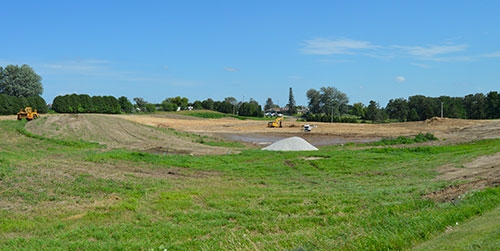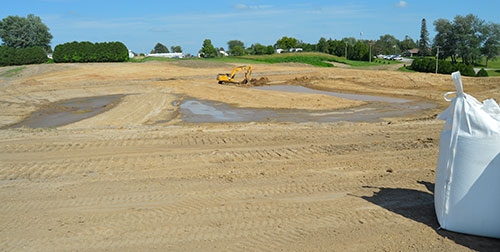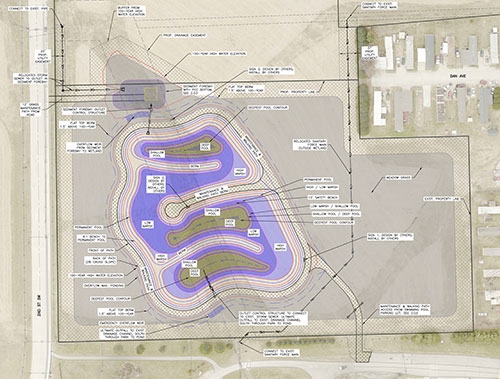You are here
Home ›Water quality improvement project taking shape near Waukon City Park

Submitted photo.

What’s starting like this (two images above)... will end like this (image below) ... Excavating work being done just north of the Waukon City Park to the east of 2nd Street SW is the initial phase of a Storm Water Quality Improvements project being undertaken by the City of Waukon and utilizing more than a million dollars of funding available through the State of Iowa. The engineering diagram below shows the aerial blueprint of a wetlands area that is part of that Storm Water Quality Improvements project and is designed to improve flooding issues that have plagued the Waukon City Park during heavy rain scenarios while also being able to take advantage of State funding geared toward water quality improvement within and downstream from the Waukon City Park. Water will flow into the wetlands area from the north (top of the diagram below and viewing perspective in the top photo above), being retained in the larger basin at the top of the diagram (the initial darker, wet-looking area just beyond the gravel pile in the top photo and the darker near-rectangle near the top of the diagram below) to allow storm run-off sediment to filter out of the water before it is slowly released into the “S” curves of the wetland area and eventually into the City Park at a much slower rate than previously experienced during stormy weather. The “S”-shaped areas evident in the aerial diagram below can be made out in the photo directly above as the raised dirt areas that appear to be surrounded by the wet areas evident in that photo directly above. Those raised areas will be used for maintaining the area and can also be utilized as walking paths by the general public once they have their native vegetation established. Submitted photos.

Submitted graphic.
City taking advantage of State funding to address flash flooding, storm run-off issues
by Joe Moses
Waukon City Manager Gary Boden and Engineer Paige Pierce of Fehr Graham Engineering provided a recent update relating to several components of the Storm Water Quality Improvement Project currently taking place near the Pladsen Subdivision and within and near the Waukon City Park. The current project most evident just north of the City Park along 2nd Street SW is the excavation taking place to create a wetland area to assist with storm run-off while being able to address water quality downstream.
Boden first addressed concerns and feedback that he has been made aware of relating to the financial impact of the storm water quality improvement sponsored projects, a side benefit of the funding of the new Wastewater Treatment Plant in Waukon. Boden explained that property taxes are not increasing as a result of these storm water quality improvement sponsored projects, nor will water and sewer rates increase as a result of these projects. Boden advised that the City of Waukon would have simply lost this opportunity for State funding if this project did not move forward, referring to the variety of storm water quality improvements taking place that address issues that have plagued the City Park area for years.
In reference to the water retention/wetlands area currently taking shape with excavation work north of the Waukon City Park, Boden added, “I think it’s a great project and an innovative and environmentally sensitive way to manage storm water. This takes care of a major infrastructure need that we have. ” Boden further discussed that similar projects are in place and have been beneficial in other communities. He said that the wetlands area will better handle water drainage from an approximately 75-acre area that has traditionally flowed through the Waukon City Park pretty much unabated and left damage to trails, roads and other areas in its wake. Boden also discussed the permeable paver parking lot that will be constructed in various areas within the Waukon City Park, another component of this project to be completed this year that will help with storm water run-off.
Boden advised that the Department of Natural Resources (DNR) and the State Revolving Fund (SRF) program have made a variety of sponsored projects possible, including the wetlands area. He explained that the City of Waukon was charged two percent interest for borrowing the funding for the new Wastewater Treatment Plant, a project that had been mandated by the State of Iowa. Boden provided a further overview of the Wastewater Treatment Plant financing, which included $10 million initially with an additional $1.85 million necessary to close out the project. He added that $11.85 million in total for the Wastewater Treatment Plant project was used for the new plant, with authorization in place to borrow up to $12.4-$12.6 million, if necessary.
Boden further explained that the two percent in interest spent in financing the Wastewater Treatment Plant could be rolled back into sponsored projects that are acceptable to the State of Iowa. He said a variety of potential projects proposed by the City of Waukon to help with storm water run-off in the City Park area, including stream bank stabilization, among others, did not meet the State’s criteria for that rollback funding, but the wetlands project did meet that criteria and qualified as a sponsored project and, thus, is currently under construction.
Boden said that the City of Waukon will likely be spending less than $60,000 towards the cost of these projects, with SRF grants providing $850,000 of the funding and two smaller grants bringing the total funding available to $1.25 million. Boden advised that the City’s contribution of $60,000 will likely come from the tax increment financing (TIF) associated with the Pladsen Subdivision. He noted the important role of private and public sector partnerships in making a project like the Pladsen subdivision a reality in a community like Waukon.
The wetlands area north of the City Park was further discussed by Boden, noting that utility lines have been moved from this area and now run next to the wetlands area and parallel to 2nd Street SW. He briefly discussed the design of the wetlands area, which he said will be completed yet this year, except for the planting of some native grasses. Boden explained that raised areas or walking paths within the wetlands area will allow for continued maintenance and the removal of sediment, along with providing additional areas for the general public to walk. Boden added that educational signage will be installed providing information relating to the marsh grasses and other native grasses to be planted within this area.
Following The Standard’s meeting with Boden, Engineer Paige Pierce with Fehr Graham Engineering was contacted relating to an overhead map of the wetlands area, as seen in the graphic accompanying this article (Page 16). Pierce added that, “This wetland is one part of six of the Storm Water Quality Improvements Project which started as an SRF Sponsored Project but has also been granted money through the Water Quality Initiative Fund and Water Infrastructure Fund. In all, the City has $1.25 million dollars of funding for these projects, of which the City will pay less than two percent of (the $60,000 previously mentioned).”
Pierce further noted that, “Four of the other divisions will also be completed this year including replacing the parking east of the sand volleyball court with permeable pavers, adding permeable paver parking alongside the road on the west side of the sand volleyball court, adding a bio-retention cell (like a rain garden, but improved soils) above the road leading to the pond, and an infiltration swale with check dams on the north side of the road leading to the pond. These projects were awarded to Skyline Construction. The final division is for native plantings at the wetland site, the bio-retention cell, the infiltration swale, and the hillside above the infiltration swale. These plantings will begin in the Spring of 2023 and be monitored and maintained by the contractor through the fall of 2024. The contractor for this division is Tom Riehm. Again, the $1.25 million applies to all of these divisions, of which the City will be almost totally reimbursed for.”
Pierce added, “We chose a wetland for this site because a standard dry detention basin does not qualify for these State funding sources. By having a permanent pool of water, we are allowing sediment to settle out of storm run-off before releasing downstream and are therefore improving water quality, which is the sole purpose of our funding sources. Knowing the City has had issues with flooding here in the past, we also wanted to address large storms as well. This is accomplished in the open space between the permanent pool and the walking path. When it storms, this free space will fill with storm water run-off before being slowly released downstream. In summary, we chose a storm water wetland for this site to address the flooding problems the City is concerned with but adding the water quality component so it becomes eligible for the State dollars.” Pierce provided the following information relating to the map graphic associated with this article (submitted graphic below):
“The sediment forebay (top darker near-rectangle in blueprint at right below) is a small pool of water that catches most of the sediment and debris before the storm water enters the wetland. Silt and sediment will enter the system and need to be removed to keep it pretty and functioning. By storm water entering the sediment forebay first and dropping out there, it’ll keep the wetland cleaner. And it is much easier to clean out the sediment forebay than the wetland.
“Everything shaded in blue (in the graphic at right) will be underwater all the time. The wetland (blue s-shaped area) is surrounded by a maintenance and walking path, with main access from beside the aquatic center parking area. This will be mowed lawn grass, mostly for maintenance, but the public will be more than welcome to walk on it once the project planting is completed. The gray shade surrounding the wetland will be tall meadow grass, and the perimeter will be mowed lawn grass, again for maintenance but the public is welcome to utilize this new space. The City gave this lot as an extension of the park, so by all means, enjoy it!
“Most of the utilities are already in the ground, the earthwork is mostly done, meaning you can really see the shape and size of the wetland when driving by or enjoying the park. Next steps will involve temporary seeding overwinter until Riehm Construction begins the permanent native plantings in the spring.” Pierce further noted that the native plantings will take a few years with much maintenance necessary in being established and as a result, Riehm’s contract will continue through fall 2024. She noted that the appearance of the wetlands area will take a few years to be realized, with Pierce adding, “But once the native plants are fully established, it should be really beautiful.”

